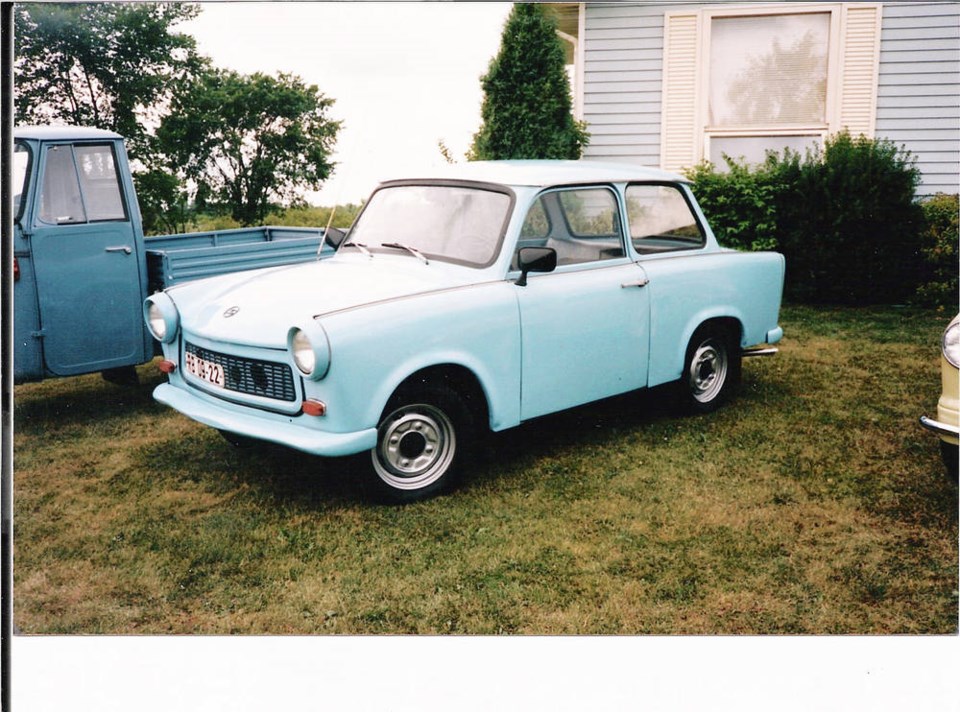When the Berlin Wall fell in 1989, the stream of Trabants, a kind of East German people’s car, rolling across the border vividly demonstrated the backward state of consumer technology in Communist-occupied countries. It was painfully obvious that it had not changed since the Second World War.
The fall of the Wall coincided with the “Trabbi’s” 30th anniversary but nobody seemed to notice, or care. In a sea of sleek, low-emission, efficient West German automobiles, it was a true anachronism.
The Trabant (meaning fellow traveller) P50 was introduced in 1959 and had not advanced much since then. And even when new, it was based on pre-Second World War DKW technology.
Following the war, the Potsdam Agreement divided Germany into four zones which were distributed among the Allies: United States, Soviet Union, Britain and France. Several German automobile plants, including BMW and Audi, ended up in the Soviet Communist zone.
The Communists promptly nationalized them and bound several together into one conglomerate called Industrie-Verinigung Volkseigner Fahrzeugwerke, known as IFA.
IFA’s first car, the F8, appeared in 1948, followed in 1950 by the larger F9. Both were based on pre-war DKWs and were made in Audi’s former plant in Zwickau, although F9 production soon moved to an ex-BMW plant in Eisenach.
The F9 was renamed the Wartburg in 1956, the year the F8 was replaced by the Zwickau P70. The P70 became the Trabant in 1959, manufactured by VEB Sachsenring Automobilwerk Zwickau.
The Trabant was basic by Western standards. Its 506 cc, inline, two-stroke, two-cylinder air-cooled engine sat transversely in the front, powering the front wheels through a four-speed, column-shifted manual transmission.
Instrumentation was a speedometer only. Gasoline level in the tank located under the hood was checked with a dipstick. The engine had no oil sump, lubrication being achieved by adding oil to the gasoline at every fill at a 50:1 ratio. This could be messy so some stations sold a pre-mixed gas-fuel mixture.
The oil burned with the gasoline, accounting for the characteristic blue haze that followed Trabbis around. To prevent engine seizure during extended coasting when the cylinders got little lubricating oil, the transmission had free-wheeling. This disconnected the driveline while coasting but the lack of compression braking put extra strain on the non-power assisted, four-wheel drum brakes.
The four-wheel independent suspension was uncomplicated with lower control arms front and rear and single transverse leaf springs acting as the upper arms. Steering was non-power rack-and-pinion.
The unit construction body was clad in non-rusting fibreglass reinforced plastic and came as a two-door sedan and station wagon known as the Universal. A Jeep-type open four seater was added in 1978. Trabbis were generally limited to three colours, green, grey and brown.
The Trabant was quite small, with a 2,019-millimetre (79.5 inch) wheelbase and length of only 3,556 mm (140 in.). It weighed about 635 kilograms (1,400 pounds).
Performance was modest, even by 1959 small car standards. Car and Driver (12/90) reported zero to 97 km/h (60 mph) in 32.2 seconds and top speed of 106 km/h (66 mph). This was with a 1989 model with the 26 horsepower, 594 cc engine fitted from 1962 on; original 506 cc models were even slower. Fuel consumption was 11.8 to 8.3 L/100 km (24 to 34 mpg).
To place its performance in some perspective, a 1960 Volkswagen, West Germany’s and the world’s most popular small car tested by Road & Track (12/59) accelerated to 97 (60) in 27.8 seconds, and reached a top speed of 115 (71.5). Although the VW was among the slower cars sold at that time, it was still faster than the Trabant. And VWs and others got faster over the years while the Trabbi didn’t.
Not much changed with the Trabant during its three decades plus. The main one was the noted 1962 engine capacity increase, making it the Trabant 601. But a waiting list extending up to a dozen years wasn’t much incentive for Central Planning to improve this. When production ended in the early 1990s, more than three million had been built.
The Trabbi was the soul of simplicity. There was no water pump, radiator, camshaft, cam drive, poppet valves or fuel pump (gasoline flowed by gravity like a model A Ford). There was no oil to change and no brake or steering assists. It was so basic it could be repaired using simple hand tools.
Because it is so far below Canadian and American emissions and safety standards Trabbis are persona non grata with the U.S. Environmental Protection Agency and Transport sa���ʴ�ý. Thus only a handful have reached North America.
Enthusiasts considering acquiring one to drive should inquire in advance whether they will be permitted to license it for the road.



